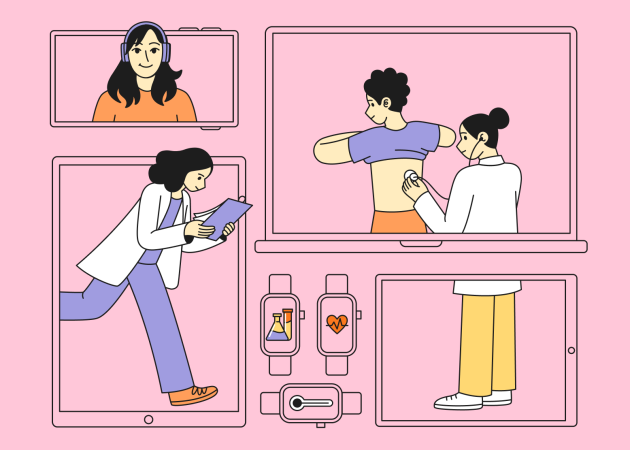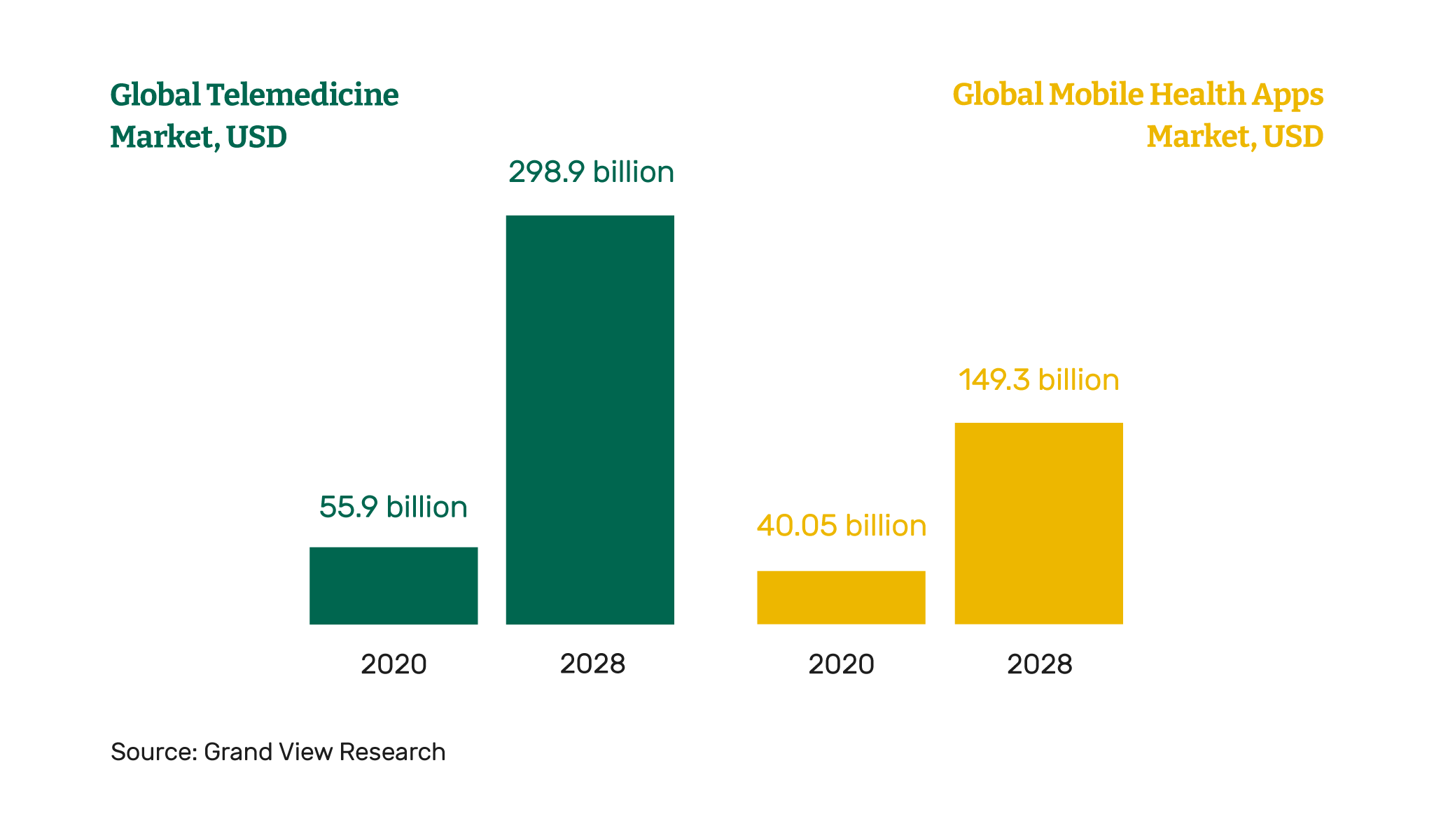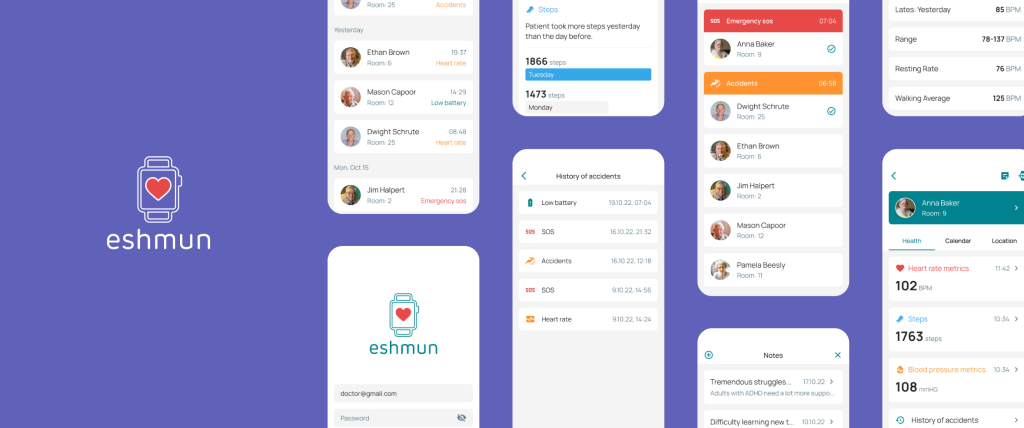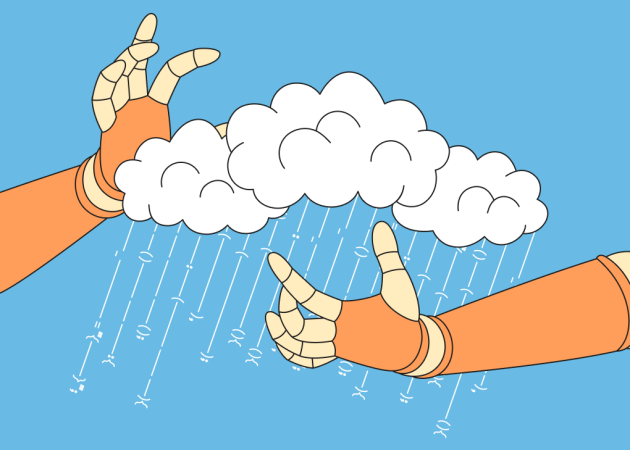
What is Internet of Things in Healthcare?
Contents
Contents
The healthcare landscape is heavily influenced by digital tools and technological advancements, with physicians adapting to the industry’s evolving demands, such as virtual care. For a while, Electronic Health Records (EHRs) have represented one of the most significant technological leaps, putting various functions into a single system. However, challenges remain – making healthcare systems work together is tough due to dispersed patient data. Usability issues and concerns about EHRs contributing to clinician burnout also complicate the landscape.
Amid these challenges, the Internet of Things (IoT) has emerged as a transformative force, extending the capabilities of healthcare providers beyond traditional clinical settings. Remote patient monitoring (RPM) technologies leverage IoT sensors to provide real-time health data, mitigating the need for unnecessary in-person visits. As the demand for remote care persists, IoT-driven innovations shape the future of healthcare, enhancing accessibility and transforming patient monitoring.
In this article, we’ll cover the core advantages of IoT in healthcare, go over the most common use cases, and share tips for overcoming the challenges that may arise along the way.
The Significance of IoT in Healthcare
First things first, let’s determine what IoT stands for in the medical context. The Internet of Things in healthcare is an interconnected web of smart devices and sensors that collect, transmit, and analyze health-related data. In addition to wearables like fitness trackers and smartwatches, IoT in healthcare may also include medical devices like smart glucose monitors, connected inhalers, smart hearing aids, and entire home monitoring systems equipped with sensors. This interconnected ecosystem enables real-time data transmission to healthcare professionals, ensuring a proactive and personalized approach to patient care.
So, how impactful are these technologies? Here are a few numbers to answer this question:
- The global IoT in healthcare market was valued at US $53.64 billion in 2024, reached US $65 billion in 2025, and is expected to grow at a compound annual growth rate (CAGR) of 21.24% by 2034.
- The number of global mobile IoT connections surpassed 4 billion in 2024 and is forecast to grow at a CAGR of 15% by 2030.
- By 2034, the global remote patient monitoring (RPM) software and services market is projected to reach around US $230 billion from the estimated US $15.5 in 2025. North America dominated this sector in 2024 with a 51.24% market share.
Though the pandemic is over, its influence on the healthcare industry is irreversible, and that includes the surge in demand for IoT devices. These technologies empower healthcare providers to remotely track patients’ vital signs and health data remotely, facilitating early detection of potential complications, enhancing disease management, and reducing hospital readmissions.

Today, the key factors propelling industry growth include:
- rising investments in digital technologies within healthcare institutions;
- the emergence of connected care;
- growing geriatric population;
- the increasing prevalence of chronic conditions;
- the widespread application of smart devices and wearables in healthcare.
On top of these factors, it’s also important to recognize the impact of IoT on patients and the healthcare system in general. Here, we gathered the key practical benefits of IoT in healthcare you need to know about.
Enhanced Remote Patient Monitoring
IoT in healthcare settings significantly advanced remote patient monitoring by allowing healthcare providers to access real-time data on vital signs. The technology also empowers medical professionals to intervene promptly and provides patients with continuous, non-intrusive monitoring, reducing the need for frequent clinic visits.
For instance, IoT-connected smart inhalers, such as Propeller Health’s sensor-equipped devices, monitor medication usage for individuals with respiratory conditions and transmit adherence data to healthcare professionals in real time. This ensures proactive management of chronic diseases.
Timely Detection and Intervention
Another vital function of IoT devices is their ability to serve as early detection tools, providing timely alerts for potential health issues. Let’s say an IoT-connected smartwatch equipped with health monitoring features detects irregular heart rhythms. In this case, it can alert users, prompting them to seek medical attention for potential cardiac issues. Such a proactive approach enables patients, their healthcare professionals, and caretakers to address emerging problems early, preventing the escalation of medical conditions.
Personalized Healthcare Delivery
The integration of IoT enables a more personalized approach to healthcare. For instance, with wearable devices like Fitbit monitoring specific activities, healthcare providers can create customized fitness and wellness plans for their patients. By understanding their activity levels, sleep patterns, and exercise routines, patients can get personalized fitness and wellness plans that align with their lifestyle and health goals. The healthcare provider may recommend specific exercises or activity goals if the data indicates insufficient physical activity.
IoT devices also empower patients to take charge of their health by providing access to their health data, ensuring transparency, and encouraging collaboration with healthcare providers.
Reduction in Hospital Visits
With IoT-enabled remote monitoring, healthcare professionals can drastically reduce the frequency of in-person hospital visits. Let’s consider an older person managing hypertension. Thanks to IoT technology, they can utilize a smart blood pressure monitor at home to measure and transmit blood pressure readings to healthcare professionals. As a result, patients feel continuous support without having to arrange frequent visits to the hospital.
This also contributes to better health outcomes since patients benefit from less time spent in waiting rooms and more quality time with their families. For healthcare providers, this results in the opportunity to focus on managing critical cases that require in-person attention.
Optimized Healthcare Resource Utilization
Utilizing IoT devices streamlines healthcare processes, minimizing wait times for patients and optimizing resource allocation for healthcare facilities. Since the devices transmit real-time data to a centralized healthcare system, healthcare professionals can access timely patient health status updates without requiring manual data collection or regular check-ins. If the device determines any irregularities in a patient’s condition, healthcare providers receive immediate alerts. This enables swift intervention and allows professionals to prioritize care for patients who require urgent attention.
To sum up, these advantages of IoT in healthcare showcase how the technology can be of great help to all parties involved in the healthcare process. If you’re interested in other health tech trends, check out our article about strategies for staying ahead in this industry.
IoT Use Cases in Healthcare
Now that we’ve established the core benefits, let’s dive into how IoT technology works in clinical settings and beyond to benefit patients, medical professionals, and healthcare facilities.
For Patients
Remote patient monitoring (RPM): By 2026, more than one-quarter of the US population will regularly use a device to track their well-being or medical data. That’s not surprising: IoT devices enable patients to monitor their health from the comfort of their homes, providing real-time data to healthcare providers.
One of many examples of IoT RPM devices is BioSticker by BioIntelliSense. This wearable coin-sized sensor adheres to the patient’s chest, continuously collecting vital sign data, such as heart rate, respiratory rate, skin temperature, and body position. Then, the device transmits this real-time data to a secure cloud platform accessible to healthcare providers, allowing for early detection of anomalies.
Medication adherence solutions: IoT-driven solutions can also be used to help patients adhere to their medication schedules by sending reminders and tracking medication usage, thus fostering a healthier routine. For instance, Pillsy, a Bluetooth-enabled smart pill bottle, tracks adherence based on when medication bottles are opened. The Pillsy Smart Cap sends reminders by beeping and blinking when it’s time to take a scheduled medication dose. Notifications can also be sent to the patient’s or their caregiver’s phones.
Wearable health trackers: Many people use wearable devices to monitor their fitness levels, sleep patterns, and overall well-being. However, there are also solutions tailored to people with more specific needs. For example, Embrace2 by Empatica is a wearable device designed for individuals with epilepsy. This smartwatch monitors physiological signals, including electrodermal activity (EDA) and motion, to detect seizure patterns. The device alerts caregivers or designated contacts when potential seizure activity is detected, allowing for timely assistance.
For Physicians
Remote consultations: IoT facilitates remote consultations, allowing physicians to connect with patients virtually and review real-time health data. It can be a lifesaver for patients with limited mobility or those living in remote areas. TytoCare, for instance, is an innovative telehealth solution that combines a handheld examination device with a secure communication platform. Patients can use it to capture high-quality images of their skin, throat, ears, and more, sharing this data with healthcare providers for accurate remote consultations.
Data-driven treatment: IoT data empowers physicians to tailor treatment plans based on real-time patient data, improving precision and effectiveness. As a result, doctors use data to create treatment plans that suit patients’ unique needs. GE Healthcare CARESCAPE leverages IoT to continuously monitor patients’ vital signs in a hospital setting. With this solution, healthcare professionals can remotely access real-time data, such as heart and respiratory rates, ensuring prompt intervention when needed.
For Healthcare Facilities
Asset tracking and management: IoT devices in hospitals are often used to track and manage medical equipment, reducing the risk of asset misplacement and optimizing resource utilization. If every piece of equipment in a medical facility is accounted for in real time, it means that resources are where they’re needed at all times, creating a seamless experience for both staff and patients. One of the examples is AeroScout Patient Flow, an IoT-based solution that helps optimize patient flow within a hospital with real-time location systems (RTLS) to track the movement of patients, staff, and equipment.
Smart environmental monitoring: Healthcare facilities store many temperature-sensitive products, including medications, blood samples, and lab tests. Therefore, maintaining optimal environmental conditions is crucial for patient safety and operational efficiency. Hospital environmental monitoring systems are typically used to ensure that air temperature and humidity levels remain within safe thresholds. IoT sensors enable real-time updates and alerts so the staff can maintain a controlled environment and quickly address fluctuations.
If you work in the healthcare industry, you may also find our eBook on developing telemedicine applications helpful.
Challenges of the IoT in Healthcare Industry
IoT implementation in healthcare is a complex process, especially since you have to ensure everyone involved is on board with the idea for it to be effective. Naturally, its adoption comes with a number of challenges. Luckily, there are strategies to tackling each one of them — and that’s what we’ll focus on in this section.
Data Security and Privacy Concerns
With sensitive patient data transmitted and stored through IoT devices, the technology poses potential data security risks if not adequately protected. Moreover, the interconnected nature of IoT devices makes healthcare systems even more vulnerable to cybersecurity threats. Therefore, healthcare organizations have to navigate an intricate landscape of securing data in transit and at rest to ensure patient confidentiality and comply with privacy regulations such as HIPAA.
To address data security and privacy concerns in IoT healthcare implementations, we typically suggest the following security measures:
- Implementing end-to-end encryption for data in transit;
- Employing secure protocols for data storage;
- Conducting regular security audits and updates to IoT devices;
- Ensuring comprehensive staff training on cybersecurity best practices;
- Complying with data privacy regulations;
- Adopting a privacy-by-design approach.

Interoperability Issues
Connecting different types of healthcare devices can be tricky because they often use different ways of sharing information with each other. Simply put, there are a lot of IoT devices from various manufacturers, many of which employ different communication protocols and standards. When data can’t flow seamlessly between devices and systems, it can lead to fragmented patient information, making it challenging for healthcare providers to provide the best possible care.
When addressing interoperability challenges, healthcare providers need to prioritize the following:
- Developing and adopting standardized communication protocols for IoT devices;
- Establishing industry-wide standards to allow different devices and systems to communicate seamlessly;
- Investing in middleware solutions that can act as interoperability bridges between different systems within the existing healthcare infrastructure.
Cost of Implementation
The implementation of IoT involves acquiring and deploying IoT devices, in addition to investing in the necessary software infrastructure to support them. Therefore, the upfront costs associated with this process can pose a considerable challenge for healthcare organizations, especially smaller practices or facilities with limited budgets.
To address the cost challenge, healthcare organizations can consider:
- Conducting a comprehensive cost-benefit analysis before implementation;
- Embracing phased implementation strategies, meaning that instead of adopting IoT technologies across the entire organization at once, they can prioritize specific areas or departments;
- Seeking partnerships with technology vendors that offer flexible payment models;
- Exploring government incentives and grants for healthcare digitization.
Resistance from End Users
Though IoT in healthcare is designed to help healthcare professionals, medical facilities may face resistance from medical workers if the innovation is not presented correctly. The staff may have concerns about job displacement, changes in workflow, or unfamiliarity with new technologies. Also, professionals may be hesitant to adopt these technologies if they seem like additional complexities in already demanding work environments. Therefore, addressing these fears and communicating the intended benefits is extremely important.
To be more specific, healthcare facilities can address user resistance by:
- Involving healthcare professionals in the decision-making process;
- Providing comprehensive training programs;
- Being transparent and communicating about the staff’s concerns;
- Creating a supportive and collaborative culture that encourages continuous learning;
- Collaborating with the tech team to make sure the new solutions fit into the existing workflow without making the lives of healthcare workers more complicated.
Future of IoT in Healthcare
The Internet of Things has proven that it is with us to stay for good. The future of this technology will likely focus on minimizing the challenges that come with it, such as achieving interoperability and enhancing security measures. However, there are a few other trends that are expected to dominate the landscape in the coming years.
Advancements in Wearable Technology
Wearable devices have already evolved beyond fitness trackers, incorporating advanced health monitoring capabilities. Future wearables are expected to offer real-time data on complex health metrics, expanding diagnostic capabilities and enabling early detection of potential issues.
The wearables of the future will empower users to proactively manage their health while also providing healthcare providers with a comprehensive view of their patients’ day-to-day health patterns.
AI Integration for Data Analysis
While we already see this trend unfolding, the integration of artificial intelligence (AI) with IoT devices will become even more prevalent, enhancing the analysis of vast datasets generated by interconnected systems.
In synergy with AI, IoT devices can collect real-time data on patient health and environmental factors. AI algorithms then analyze this data, identifying patterns, anomalies, and correlations that might be challenging for human analysis. The insights extracted from this collaborative approach enable healthcare professionals to make more informed decisions, personalize patient care, and predict potential health issues.

Connected Healthcare Ecosystems
Connected healthcare systems are expected to be the next big trend in IoT healthcare due to their potential to revolutionize healthcare delivery. By interconnecting medical devices, wearables, and other IoT-enabled tools, healthcare systems can create an integrated and intelligent ecosystem.
Smart hospitals that leverage IoT to enhance patient experiences will be able to optimize resource utilization and improve the overall quality of healthcare services. The data collected from various devices can be analyzed to identify trends, offering valuable insights for proactive and preventive healthcare strategies. This connectivity will enable real-time monitoring of patient health, streamlined workflows, and data-driven decision-making.
IoT in Healthcare Development Considerations
When looking for a tech partner to help you implement IoT technology into your operations, there are three main things we suggest considering:
- Relevant tech expertise combined with in-depth understanding of the healthcare field to make sure the team is ready to deal with the challenges of this complex landscape;
- Cross-domain experience as a way to foster flexibility, promote interdisciplinary collaboration, and encourage experimentation;
- Alignment in terms of values to ensure a shared vision, foster a purpose-driven environment, and successfully reach the overall mission.
Implementing IoT in healthcare can be intricate due to the complexity of integrating diverse devices, especially in healthcare, where medical data requires an incredibly meticulous approach to privacy. Finding tech partners for both hardware and software implementation with expertise in navigating these complexities is crucial for the project’s success.
In line with these considerations, Beetroot’s involvement in health tech IoT projects exemplifies the integration of these key aspects.
With healthcare being one of our focus industries, Beetroot has the experience that allows us to be a reliable ally in developing software solutions for IoT in healthcare projects.
One of our projects in the field is an alarm management platform for care by Skyresponse, a Swedish technology company. To give you an idea of what cooperation with Beetroot might look like, here is what Jani Wallma, the company’s DevOps manager, wrote about working with our team on Clutch:
“Beetroot AB’s team is always focused on learning new things and taking every development process in the right direction — that’s why they’ve kept improving throughout the partnership. They also change a resource if needed, but we haven’t done that in the last two years.
Beetroot AB’s focus on their customer’s needs is impressive; they always understand our needs and quickly assign the right person to address them.”
Take, for instance, Eshmun, Beetroot’s in-house R&D project. This ongoing development of a telehealth app, tailored for nurses, medical practitioners, and family caregivers, leverages proprietary IoT devices for telenursing. It aims to enhance the quality of life for seniors and extend the capabilities of healthcare providers, reflecting Beetroot’s deep understanding of healthcare challenges and its commitment to innovative solutions.

In addition to relevant experience, another factor worth considering when looking for tech partners is the alignment in terms of fundamental values and goals. Searching not just for skilled but like-minded specialists increases your chances of building impactful solutions. You can read more about this approach in our white paper on building high-performing remote teams, for which we relied on our cooperation with a well-known HealthTech company (confidential due to NDA) to develop an IoT mobile app solution enabling users to control their air purifiers and monitor the air quality in their homes. Additionally, our past collaboration with Abilia, a company specializing in assistive technology and medical devices for people with special needs, further demonstrates our ability to align with organizations that have a significant societal impact.
Building Mindful Healthcare Environments
The future of healthcare is inevitably linked to IoT technology, which promises more patient-centric, data-driven, and interconnected health systems. This is a future where the needs of both patients and healthcare professionals are a priority, and the healthcare ecosystem is more mindful, compassionate, and responsive.
If you want to contribute to this future but don’t know where to start, Beetroot is here to help. Dedicated to making a sustainable impact, our team is open to new projects in the healthcare field. Feel free to reach out so that we can discuss your project goals and possible ways to achieve them through tech innovation together.
Subscribe to blog updates
Get the best new articles in your inbox. Get the lastest content first.
Recent articles from our magazine
Contact Us
Find out how we can help extend your tech team for sustainable growth.






